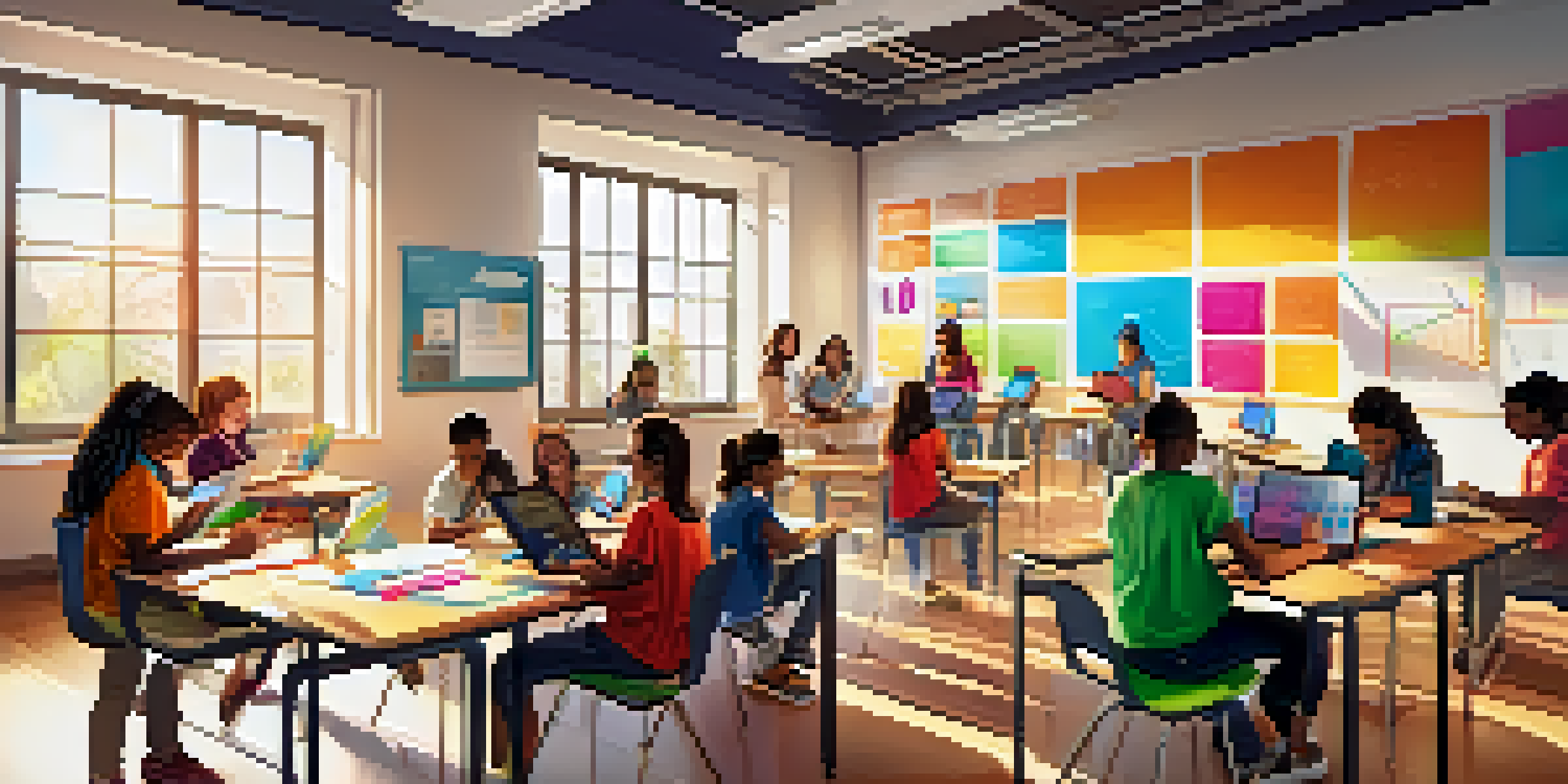How Mobile Learning Supports Collaborative Learning

Understanding Mobile Learning in Today’s Context
Mobile learning refers to educational experiences delivered through mobile devices, such as smartphones and tablets. This approach allows learners to access resources anytime and anywhere, making education more flexible and accessible. With the rise of mobile technology, learning is no longer confined to traditional classrooms, opening the door for innovative teaching methods.
Education is the most powerful weapon which you can use to change the world.
The convenience of mobile learning means that students can engage with educational content during their daily routines, whether commuting or waiting in line. This accessibility encourages continuous learning, where information can be consumed in bite-sized chunks. Consequently, it also fosters a mindset of lifelong learning, essential in today’s fast-paced world.
Moreover, mobile learning tools often incorporate features that enhance interactivity, such as quizzes, videos, and discussion forums. These elements not only make learning enjoyable but also create opportunities for learners to engage with peers, setting the stage for collaborative learning experiences.
The Role of Collaboration in Learning
Collaboration in learning refers to students working together to achieve common educational goals. This process enhances critical thinking, creativity, and problem-solving skills as learners engage with diverse perspectives. In a collaborative environment, students are more likely to deepen their understanding of the subject matter and retain knowledge effectively.

When learners collaborate, they develop essential interpersonal skills, such as communication, negotiation, and conflict resolution. These skills are not only vital in educational settings but are also invaluable in professional life. By working together, students learn to appreciate the strengths and weaknesses of their peers, fostering an inclusive learning atmosphere.
Mobile Learning Enhances Flexibility
Mobile learning allows students to access educational resources anytime and anywhere, promoting a more flexible and accessible learning experience.
Furthermore, collaborative learning often leads to increased motivation and engagement. When students feel that they are part of a team, they become more invested in their learning journey, leading to improved academic outcomes. This sense of community can be further amplified through mobile learning platforms that facilitate group interactions.
Mobile Learning Tools That Enhance Collaboration
Numerous mobile learning tools are designed specifically to promote collaboration among learners. Applications such as Google Classroom, Microsoft Teams, and Slack allow students to communicate, share resources, and work on group projects seamlessly. These platforms break down geographical barriers, enabling students from different locations to collaborate effectively.
Collaboration allows us to know more than we are capable of knowing by ourselves.
Another great tool is discussion forums embedded in mobile learning applications. These forums allow learners to engage in meaningful conversations outside of the classroom, giving everyone a voice to express their ideas and opinions. This asynchronous communication model ensures that all learners can participate at their own pace, making collaboration more inclusive.
Moreover, mobile learning apps often include features such as file sharing and real-time editing. This functionality encourages teamwork by allowing students to co-create documents and presentations, providing a hands-on approach to learning. By using these tools, learners can actively contribute to group projects, enhancing their overall educational experience.
The Impact of Social Media on Collaborative Learning
Social media has transformed the educational landscape by providing platforms for collaborative learning. Apps like Facebook, Twitter, and Instagram allow learners to connect with peers and share insights beyond the classroom. This connectivity fosters a culture of collaboration, where students can seek help, share resources, and celebrate each other’s successes.
Additionally, social media encourages the exchange of diverse viewpoints, enriching discussions and enhancing critical thinking. Students can join groups or communities focused on specific subjects, allowing them to engage with like-minded individuals. This interaction not only helps them learn from one another but also broadens their horizons.
Collaboration Boosts Engagement
Working together in learning environments enhances motivation and fosters a sense of community, leading to improved academic outcomes.
However, it's essential to use social media mindfully to ensure a positive learning experience. Educators can guide students on best practices for online interactions, promoting respectful communication and constructive feedback. By leveraging social media effectively, learners can harness its potential as a collaborative learning tool.
Gamification: Engaging Learners in Collaboration
Gamification involves incorporating game elements into the learning process to enhance engagement and motivation. When applied to collaborative learning, gamification can transform tedious tasks into exciting challenges. For instance, students can participate in team-based competitions that require them to work together, fostering a sense of camaraderie and teamwork.
Through gamification, learners are encouraged to collaborate to achieve common goals, such as completing missions or solving problems. This approach not only makes learning more enjoyable but also promotes deeper engagement with the content. As a result, students are more likely to retain information and apply it in real-world scenarios.
Moreover, gamification can provide instant feedback, which is crucial for collaborative learning. By tracking progress and celebrating achievements, students can see the impact of their teamwork. This feedback loop reinforces positive behaviors and encourages continuous improvement, making the learning process more dynamic.
The Challenges of Mobile Collaborative Learning
While mobile learning offers numerous benefits for collaboration, it also presents unique challenges. One significant issue is the potential for distraction, as mobile devices can easily divert attention to social media or games. Educators must find ways to keep students focused on collaborative tasks while navigating the digital landscape.
Moreover, not all students have equal access to mobile technology, which can create disparities in collaborative learning experiences. Educators need to be mindful of these differences and strive to provide equitable opportunities for all learners. This may involve offering alternative resources or support for those who lack access.
Technology Shapes Future Learning
Emerging technologies like VR/AR and AI are set to transform mobile collaborative learning, personalizing experiences and enhancing inclusivity.
Lastly, there’s the challenge of ensuring effective communication among team members, especially in virtual settings. Misunderstandings can arise in online discussions, leading to frustration and diminished collaboration. Educators can help by establishing clear communication guidelines and encouraging regular check-ins among group members.
Future Trends in Mobile Collaborative Learning
As technology continues to evolve, so too will mobile collaborative learning. One exciting trend is the integration of virtual and augmented reality (VR/AR) in educational settings. These immersive technologies have the potential to create engaging collaborative experiences, allowing students to interact in virtual environments, regardless of their physical location.
Furthermore, artificial intelligence (AI) is poised to play a significant role in personalizing collaborative learning experiences. AI-driven platforms could analyze individual learning styles and preferences, recommending tailored resources and group dynamics. This customization could enhance collaboration by ensuring that every learner's needs are met.

Lastly, as mobile devices become even more ubiquitous, the focus on inclusivity in collaborative learning will likely increase. Educators and developers will continue to explore ways to make mobile learning accessible for all students, ensuring that collaboration thrives in diverse environments. This commitment to inclusivity will ultimately lead to richer and more meaningful learning experiences.